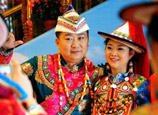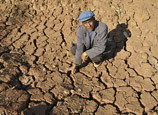
3. Unremittingly doing our work related to agriculture, rural areas, and farmers well, and consolidating and strengthening the position of agriculture as the foundation of the economy
We carried out agricultural modernization while deepening industrialization, application of information and communication technologies (ICT), and urbanization, and we pooled resources to accomplish a number of major tasks that are important to the long-term development of agriculture and rural areas and to the vital interests of farmers.
-- We increased central government spending on agriculture, rural areas and farmers, which totaled 4.47 trillion yuan for the past five years and rose by an average annual rate of 23.5%.
-- We established a sound system for subsidizing grain farmers and a sound mechanism for subsidizing major grain-producing areas, broadened the coverage of the subsidies, and raised them every year, from 63.9 billion yuan in 2007 to 192.3 billion yuan in 2012.
-- We provided more rural financial services, and the outstanding balance of bank loans to agriculture, rural areas and farmers increased from 6.12 trillion yuan at the end of 2007 to 17.63 trillion yuan at the end of 2012.
-- We carried out the policy of minimum grain purchase prices and raised the floor prices for wheat and rice between 41.7% and 86.7%.
-- We intensified protection of farmland and farmers' rights and interests, and made a lot of preparations to improve the system of compensating for expropriation of rural collective land.
-- We made greater progress in agricultural science and technology and the development of modern agriculture, and we increased support for cultivating superior varieties and breeds, preventing and controlling animal and plant epidemics, and spreading agricultural technology in villages.
-- We built more water conservancy projects, improved rural land, developed high-grade farmland, and kept the country's total area of farmland over 121.3 million hectares.
-- Thanks to these efforts, China's overall grain production capacity reached a new level, and its grain output in each of the past six years increased and exceeded 500 million tons.
-- We strengthened rural infrastructure such as roads and water, power and methane supply capacity. We built or upgraded 1.465 million kilometers of rural roads, renovated run-down houses for 10.33 million rural households, provided safe drinking water for an additional 300 million plus rural residents, and delivered electricity to 4.45 million people in areas without power supply. This led to steady improvement in rural productivity and quality of life.
-- We encouraged surplus rural workers to find nonagricultural employment. The per capita net income of rural residents grew rapidly, and the relative income gap between urban and rural residents has progressively narrowed since 2010.
-- We deepened overall rural reform.
-- We basically completed the main tasks for reforming the collective forest tenure system, made comprehensive progress in determining, registering and certifying collective land ownership, and carried out trials for registering contracted rural land-use rights.
Sound agricultural and rural development provided important support for China to counter the severe impact of the global financial crisis and natural disasters and maintain overall stability in economic and social development.
4. Steadfastly implementing the strategy for making China strong through the development of science and education, and boosting the country's core ability to sustain economic and social development
We accelerated implementation of the National Plan for Long- and Medium-Term Scientific and Technological Development; formulated and implemented the National Plan for Long- and Medium-Term Education Reform and Development, the National Plan for Long- and Medium-Term Development of Competent Personnel and the national strategy on intellectual property rights. This gave impetus to all-around progress in science and technology, education, and culture and laid a solid foundation for ensuring China's long-term development.
We gave high priority to developing education. Government spending on education totaled 7.79 trillion yuan over the past five years, increasing at an average annual rate of 21.58% to reach 4% of GDP in 2012. We allocated educational resources, giving priority to rural, remote, poor and ethnic minority areas and made notable progress in improving fairness in education. We made free nine-year compulsory education universal across the country, benefiting 160 million students. A three-year action plan for preschool education was carried out, and the shortage of preschools was eased. We improved the system of state financial aid to students, and established a system for giving students from poor families financial aid from preschool through graduate school. We spent approximately 100 billion yuan annually for this purpose and assisted nearly 80 million students. We implemented the policy of tuition-free secondary vocational education for all rural students and all urban students who study agriculture-related majors or are from poor families. The problem of providing compulsory education to children of rural migrants working in cities was basically solved, and 12.6 million children with rural residence status are now receiving compulsory education in cities. We implemented the plan for improving nutrition of rural students receiving compulsory education to the benefit of over 30 million students. We completed the project to improve the safety of primary and secondary school buildings. We sped up development of infrastructure for vocational and special education. The pay of teachers in compulsory education is now linked to their performance. Students majoring in education at teachers universities directly under the Ministry of Education were exempted from paying tuition, and the ranks of rural teachers were strengthened. The quality and level of education in China was comprehensively raised, and the gross college enrollment rate rose to 30%. The education level of the people was raised significantly, and the average length of schooling of people over the age of 15 now exceeds nine years.
We vigorously promoted innovation. The central government spent 872.9 billion yuan to develop science and technology in the past five years, with an average annual increase of over 18%. China's R&D spending accounted for 1.97% of GDP in 2012, up from 1.4% in 2007, and over 74% of this spending was made by companies. The Guidelines on Deepening Reform of the Management System for Science and Technology and Accelerating Development of a National Innovation System were adopted. We carried out a national technology innovation project and a knowledge innovation project, made solid progress in implementing major national R&D projects, and set up a number of national engineering centers, key laboratories and enterprise technology centers. We boosted basic research and research in frontier areas, made breakthroughs in a number of core and key technologies, and filled in gaps in many important products and equipment.
We implemented the strategy for making China strong through training competent personnel. We trained more personnel of all types, with the focus on high-level and highly skilled personnel. As a result, the number of personnel with special expertise and highly skilled personnel increased by 8.6 million and 8.8 million respectively. A total of 540,000 overseas students returned.
We put greater effort into developing the cultural sector. A network of public cultural facilities covering both urban and rural areas is taking shape, and all museums, libraries and cultural centers in China are open to the public free of charge. We basically transformed state-owned for-profit cultural institutions into business enterprises, and deepened reform of internal operating mechanisms of nonprofit cultural institutions. Philosophy and the social sciences, the press and publishing, radio, television and film, and literature and art are flourishing, and cultural industries developed rapidly. We made major progress in protecting cultural relics and preserving and passing on intangible cultural heritage. Cultural exchanges with other countries increased. New progress was made in nationwide fitness activities and competitive sports.


















 Recruitment of flight security officers attracts capable men
Recruitment of flight security officers attracts capable men


![]()
